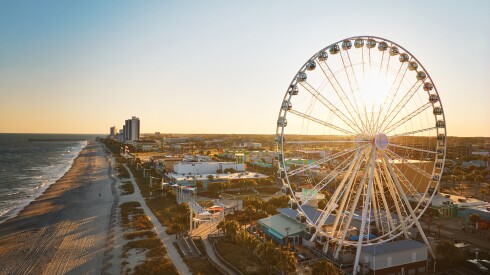Airline passengers who curtailed travel for several years during the pandemic are reacclimating to the airport experience and might be encountering surprising new procedures and technologies along the way, such as biometrics and new screening methods.
These developments, many of which began before the global health crisis but have since accelerated, can be unsettling. Knowing what to expect and whether participation is mandatory or voluntary can make the unfamiliar less daunting.
Here are the airport rights travelers need to know about during different stages of the airport journey.
Opting out of biometrics
The use of biometrics, such as facial recognition technology or fingerprinting, is on the rise in air travel and isn’t going away. The airlines, U.S. Customs and Border Protection (CBP), and the Transportation Security Administration (TSA) all began implementing facial recognition technology prior to the pandemic, but the technology has since proliferated as a touchless, tech-driven alternative for verifying identities.
Facial recognition technology is being installed at airports across the country and used by many airlines during flight boarding to reduce staffing needs and improve speed and efficiency of certain airport procedures. For some travelers, this is a welcome way to expedite the travel experience. For others, it raises privacy and accuracy concerns.
There may come a time when it is more difficult to avoid facial scans, but for now, airlines, CBP and TSA say they are voluntary and that passengers can opt out.
Be screened in private
TSA agents are required to ensure no airline passenger has an illegal weapon, contraband, or explosive. Sometimes that means making physical contact with passengers to confirm they aren’t carrying prohibited items. If a pat-down scenario arises, passengers have the right to request their screening occur in a private room.
Exemptions for children and older adults
TSA loosened the screening procedures for children under 12 and adults over 75 several years ago in an attempt to focus on higher-risk age categories. “What it came down to is that if you look at everybody, then you look at nobody,” said Jeffrey Price, an airport and aviation security expert from Metropolitan State University of Denver.
The guidelines are somewhat vague but generally permit older adults and young children to keep on shoes and light jackets when passing through the body scanners.
“Are there going to be gaps in the system because of that?” Price said. “Yes. But it comes down to what is an acceptable level of risk for aviation.”
The data on your devices
Digital privacy at airports is one of the murkiest elements of air travel, and it has become even cloudier in recent years.
Shortly before the pandemic, U.S. courts began limiting government officials’ rights to search travelers’ electronics, including phones, at U.S. border entries without a warrant or reasonable suspicion. But recent legal cases have created more uncertainty.
U.S. federal courts have ruled differently on the matter. As a result, “depending on where you fly into the country, the rules are different,” said Saira Hussain, senior staff attorney at the Electronic Frontier Foundation, a nonprofit organization devoted to digital civil liberties. And, Hussain said, “the Supreme Court has rejected at least two opportunities to review such cases.”
Civil liberty and privacy advocates have long argued the practice of tapping into devices of private citizens at ports of entry, often exposing intimate or confidential information, has gone too far. Border searches of electronic devices reached an all-time high in fiscal year 2022, according to CBP’s self-reported statistics.
Until the question is settled, Hussain recommends that passengers have a plan for their electronics when flying internationally.
If you have sensitive data on your phone—such as privileged attorney-client information or medical records—upload it to the cloud and wipe the data from your phone before going through processing. Power down devices and use alphanumeric passcodes rather than biometrics for unlocking your phone.
Know that just because the government asserts it can search your device doesn’t mean you have to hand it over unlocked, Hussain said. If you are a U.S. citizen, a border agent cannot deny you entry into the country for not unlocking your phone, but they can seize it. “We always encourage people to remain courteous to officers and never lie,” she said.
Nursing rooms and changing tables
Breastfeeding mothers who travel face many logistical hurdles, and the U.S. government has decided that having a place to nurse or pump in between flights shouldn’t be one of them. The Friendly Airports for Mothers (FAM) Act was incorporated into the Federal Aviation Administration’s Reauthorization Act and signed into law in 2018, requiring all large and medium airports to provide clean, accessible, private rooms in every terminal for nursing mothers. This was extended to all small hub airports in 2020. The law also requires those same airports to install baby-changing tables in both men’s and women’s restrooms.
Traveling with milk, formula, and baby food
The TSA has an important exemption to its hard-and-fast 3-1-1 liquids rule for those transporting breast milk, formula, or food for infants and toddlers, including puree pouches. While the average traveler must pack liquids in containers smaller than 3.4 ounces—and then shove those bottles in a single quart-sized clear plastic zip-top bag—liquids deemed “child nourishment” are exempt from those limitations, as are medications. Breast milk can be brought through security with or without the child present. Ice packs and coolers are also allowed as a means of transporting these items.
Religious and cultural exceptions
TSA pat-downs and screenings are more than simply a dreaded nuisance; they can conflict directly with religious and cultural beliefs and sensitivities. For people whose beliefs forbid certain articles of clothing or artifacts to be touched by nonpractitioners, the TSA will try to do what it can to accommodate those parameters. Talk to an agent about your screening concerns and request to speak with a supervisor if you feel your concerns are not being heard.
This story was originally published in November 2019 and was updated on February 5, 2024, to include current information.








